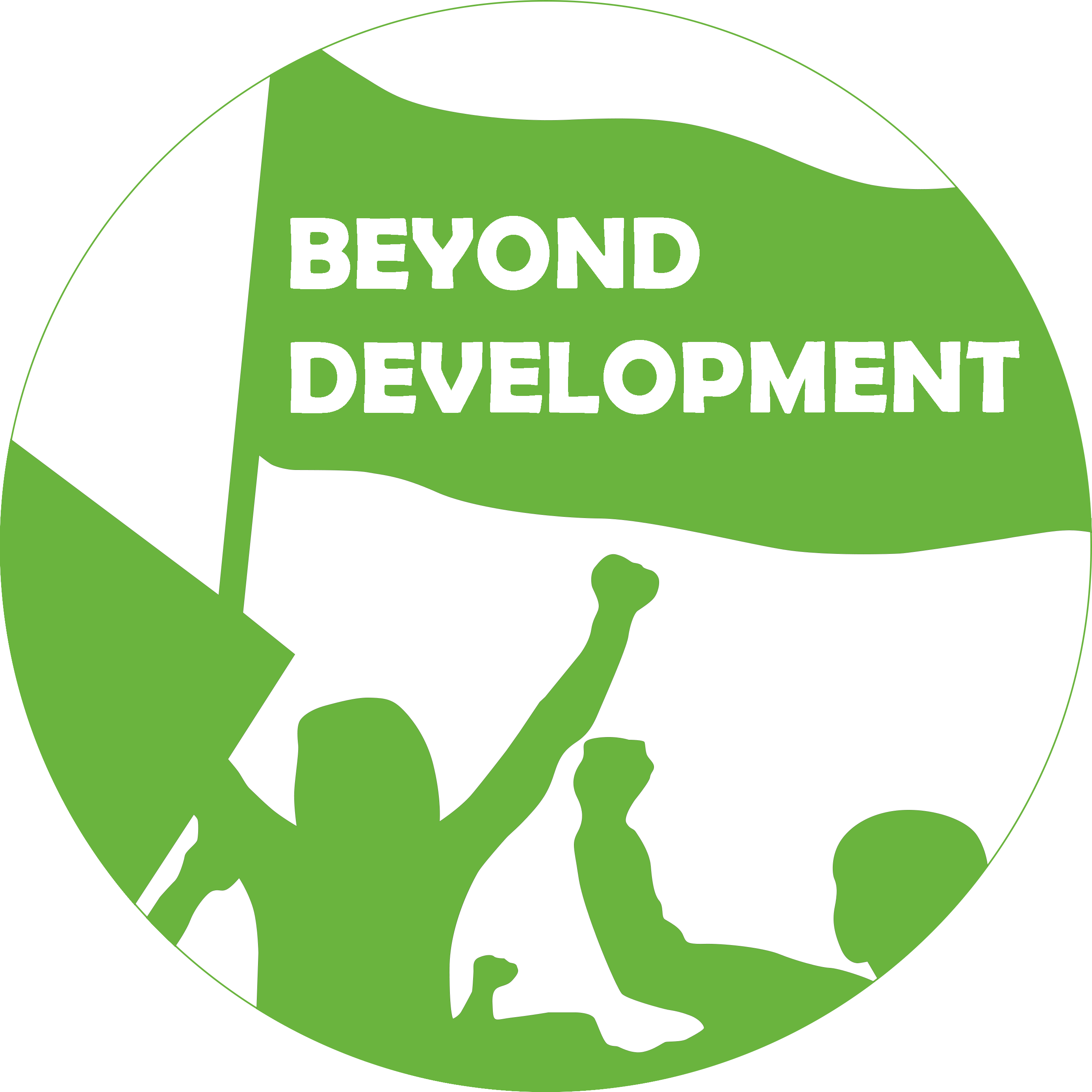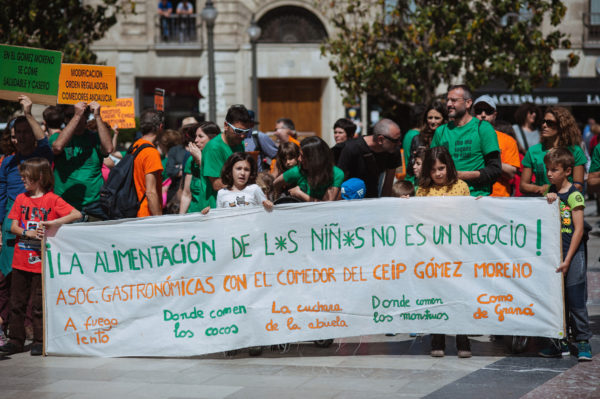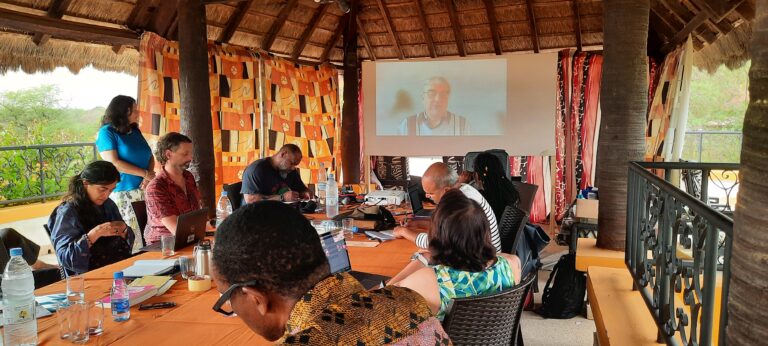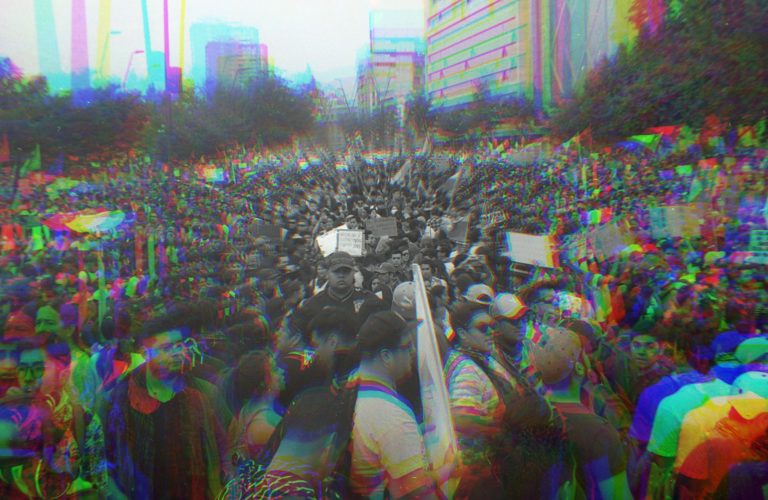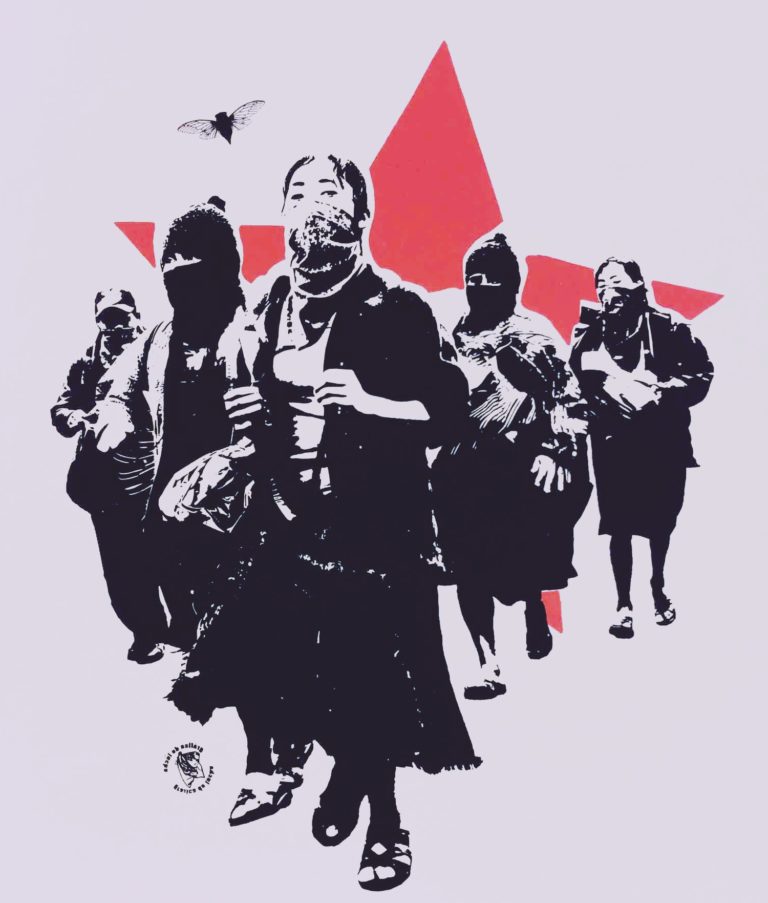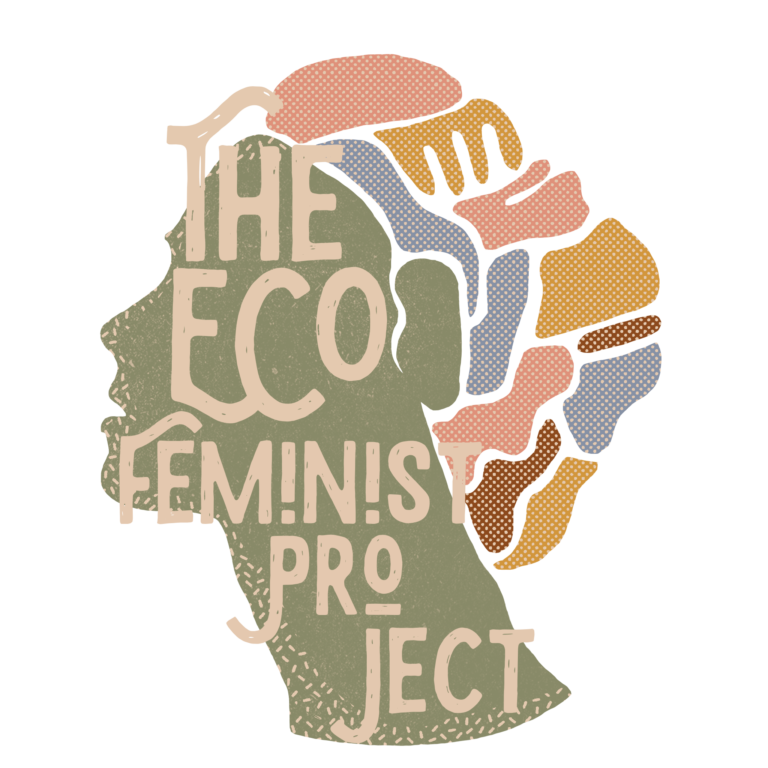by Kitti Baracsi
If we imagine democratic education as entire school communities practising participation, to what extent can schools escape the current approach taken in the public education system? What if they encounter hostility and restrictions? Can we learn democracy through transgressions and resistance? This article tells the story of three school communities where participation and solidarity are growing under pressure.[1] Examining democratic practices on the ground and the conflicts that arise gives us insights into what is at stake in state schools.
Having a say, feeling part of a community
“When your kids attend a state school, you usually just take them there and pick them up. Nobody ever asks you how to do things, so in return, you do nothing[1] . That’s it; somehow you become too unconcerned. But this school was different. We had to think about what was important to us”, says Katalin Walter, whose daughter attended Vadgesztenye school in Pécs-Somogy, on the outskirts of Pécs, Hungary.[2] This small, previously pretty much unknown state elementary school made national news following the rise and fall of a community-based project launched in 2017.[3] It all began with an idea by Erika Csovcsics, who at the time ran the group of institutions to which this small school belonged.[4] Radical methodological changes had been introduced, e.g. working in mixed-age groups, with some teaching done outdoors, in nature for instance. Many of the introduced practices emphasised the importance of the community. Accordingly, a number of middle-class families decided to enrol their children at this school, which was already caught up in the segregation process.[5] They could have chosen to send their children to another school, but felt they would get an exceptional education there. The initiative counted on the participation of families, with working groups formed to reach decisions about educational issues and to closely monitor what went on at the school.

Protest, Granada, 2018 (Photo by Kathryn Palmateer)
“You know, the principal reason for enrolling my children at this school was the organic canteen”, was something that parents of kids attending the Gómez Moreno elementary school in Albayzín, a district of Granada in Spain, would often say.[6] The issues here are not simply the importance they attach to their children’s eating habits and health, or teaching food sovereignty. Since the school canteen has been managed by the families’ association for 17 years now, parents’ direct involvement and collective decision-making in assemblies, like the organisation of a wide range of programmes in addition to the canteen, give the families involved a sense of community and agency.[7] This provided a perfect ground[2] for initiating the learning communities (comunidades de aprendizaje) project[8] back in 2015.[9] This project focuses on joint educational actions designed to foster social and educational transformation based on two key factors: interaction and community participation. Among other things, it entails direct involvement in so-called ‘interactive groups’, lessons where families and other volunteers play curriculum-related games with the children in small groups. According to María Dolores López López[10], the school’s chief of studies and volunteer coordinator over the last 4 years, this project enabled better collaboration between the families’ association and the school and also contributed towards the school’s significant improvement, as reflected in the rising number of enrolled students and greater public recognition. The families warmly welcomed the project. As she put it: “The best moment was the so-called dreaming when families talked about the school they’d aspired for their children. It was a[3] [4] moment of faithfulness”.
Solidarity in action
For nine years, Marisa Esposito has been the head teacher at the Stefano Barbato elementary school in the 69º teaching district in Barra, a neighbourhood of Naples in Italy, where she has taken several initiatives aimed at enabling families and the community as a whole to play an active role. Talking about the importance of community and the fight against the territory’s disintegration, she mentioned a ‘time bank’, a grandparents party, events with local artists and a project on neighbourhood legends, in which mothers found a narrative space to talk about their life, suffering and childhood. “We believe in the idea of the[5] educational community. Whatever we teach children, they must find it at home, too”, she said in an interview in 2018.[11] According to Marisa Esposito, the neighbourhood where she was brought up has changed over the years, turning into a place where fear and individualism dominate due to the presence of organised crime. She therefore sees the main purpose of the school as being to restore cohesion in the local community. According to her, though, families do not see how education could offer their children a better future. Still, the school is almost their only reference point, since the neighbourhood has no other cultural spaces. Marisa’s mission through the years has been to include Roma students. Thanks to her approach, based on her experience as a social educator, [6] children felt free to go to her office and ask for advice or support.[12]
Similarly, the changes introduced at the Vadgesztenye school were drawn from extensive experience and seemed to work, transforming it from an establishment with few, mainly underprivileged pupils into a place where middle-class pupils and poor, mostly Roma children met.[13] “I guess there’s no need to explain how important it is to reduce social inequalities and raise underprivileged children by educating them in Pécs. Likewise, it’s unnecessary to say why it is important for well-fed middle-class children to learn how to communicate with them and be sensitive to their needs. Because as adults, they will live together”, writes Judit Szentendrei, a mother whose children went to this school.[14] She explains that her family, along with others, consciously decided to face this challenge, taking tiny steps and facing many failures along the way. The families treat the school and local environment as a place in which to act for solidarity. Indeed, according to Judit Szentendrei, the biggest success story has been that her children learned how to live alongside others.

Learning how to live together is also a central issue in the Gómez Moreno school, which has children of approximately 25 different nationalities, some from foreign middle-class families (referred to as guiris by the locals), and others from local foster homes, with very diverse backgrounds. The learning communities include participation in classroom activities and decision-making, among other things. The work on participatory processes and solidarity seems less deliberate than it is in Vadgesztenye, but encountering different people and other realities is part of everyday life for the children and their families. A transformation is under way, but progress is slow. This project, as in Barra, crucially hinges on the presence of teachers previously trained in specific methods as well as on the dedication of the school’s management team.
Encountering hostility
The school canteen in Gómez Moreno is the only organic one run by an association of families in Andalusia. So its struggle is also symbolic. Unlike some other regions in Spain, in Andalusia there is no law giving priority to family-run organisations, so they have to compete in the same tenders with huge catering companies offering lower prices but also inferior quality, since they do not operate a kitchen on site (e.g. use local ingredients), but transport food over fairly large distances. In 2018, this prompted families − and not for the first time − to take to the streets, shouting ¡No me toques la olla! (Don’t touch my cooking pot!) and then barricade themselves inside the school for a week in a display of resistance. A major caterer won the tender, which was published and closed earlier than usual, without the association being informed or invited to take part in it.[15] But their protest was successful, and the catering company decided to hand over its contract to the association. However, their victory was only partial, because for two school years the association have t[7] o run the canteen for the price set in the tender whilst at the same time trying to adhere to their organic and environmentally friendly principles.[16] The association of families, along with other associations and platforms[17], is now calling for a change in the regulations, Clara Bermúdez Tamayo explained.[18] That said, the demonstrations seem to have helped to build a sense of community, one mother, Raquel Hernández Benítez, describing them as “exercising a collective struggle, teaching children through first-hand experience that when something is not right, we organise ourselves to fight it. This is fundamental to active, critical and intelligent citizenship”.
In the case of Barra, as explained above, it is the overall context that makes change difficult to achieve, especially introducing the idea of Roma inclusion. Even those who agreed that Roma children also need an education did not defend the head teacher when other parents attacked her views.[19] As she went on to point out, people are more prejudiced against Roma than against criminals, to whom they have become more accustomed. After many years of collaboration between the school and the Association N:EA[20], families seem to be accepting the presence of Roma children, admittedly with a degree of resignation, but as something increasingly commonplace[8] . Also, thanks to Roma inclusion projects[21] introduced in a few classes, Roma and non-Roma children have access to improved teaching methods [9] and are involved in a wider range of activities. For instance, some teachers have been trained in cooperative learning. In this regard, notwithstanding their genuinely problematic aspects[22], these projects benefit the entire school community, partly due to the head teacher’s commitment to use them to realise her vision.

In 2018, Erika Csovcsics’s application to become[10] the head teacher at the Vadgesztenye school was unsuccessful, and the new head teacher’s arrival has changed everything, returning to the ‘traditional’ approach despite the families’ efforts to reach an agreement. When families started to protest, they were accused of wanting a school where studying was unnecessary and told that administrative failings were the reason for bringing in a new principal. In the end, the families managed to find a semi-private solution: learning groups were formed with the children enrolled in a school in a nearby village, based on a special agreement. “For me, the main achievements were that we managed to find a way out and succeeded in keeping the group together. You know, we were the very families who could have looked for another school, but we resisted for a really long time because we didn’t want to leave others behind who might have had no other option”, added Katalin Walter. However, this arrangement only ended up lasting a year.[23]
This was no isolated case. Many alternative schools and learning group initiatives are not exactly welcomed by the Hungarian government. The recent amendment of the public education law[24] introduced changes in how home schooled status can be obtained[11] and to curriculum requirements affecting private alternative schools.[25] The teachers and families see this as an attempt to restrict projects that go beyond the centrally imposed agenda and have hitherto been a refuge for families who did not want to comply with it.
Resistance and devotedness
The examples described above feature different agents of resistance, but power relations within communities are another important aspect to consider. In the case of the Vadgesztenye school, reversing the spiral into segregation by bringing in middle-class families seemed the only way of saving the school. A similar situation began to take shape at the Gómez Moreno school, which had also seen fewer pupils enrolling over a number of years. However, in the Albayzín district, the presence of Spanish and foreign middle-class families in the school must be seen within the overall local context, characterised by gentrification and the conflicts deriving from it.[26]
Still, the stories in this article show how resistance by a school community, albeit fleeting in some cases, and devotedness, can change children’s education. The three examples depicted here show that transgressing the dominant bureaucratic, methodological or ideological approach can prove effective for a while, though repressive dynamics kick in again when conflicts emerge. Flexibility and initiative are key factors in enabling such projects. But hostility on the part of the public administration also seems to inspire families and activists to some extent to take control of their kids’ education and call for change in the state education system. These initiatives are often tolerated and sometimes even supported (co-financed or recognised) by the authorities, but when it comes to conflicts of interests, bureaucratic arguments take precedence. Still, resistance enables these communities to create, learn and relearn democratic processes, think about their local context and take action based on their conclusions. A situated pedagogy works with critical interventions that incorporate the particularity of a place: it understands and combats structures of oppression with reference to the immediate context.[12] [13] (Gruenewald 2003, Kitchens 2009). After all, thinking in these terms, what better way could there be of learning democratic resistance through first-hand experiences than fighting for local initiatives and adopting a solidarity-based approach?
References
Gruenewald, D. (2003). Foundations of Place: A Multidisciplinary Framework for Place-Conscious Education, in: American Educational Research Journal, 40(3), 619–654.
Kitchens, J. (2009). Situated Pedagogy and the Situationist International: Countering a Pedagogy of Placelessness, in: Educational Studies. 45(3) Critical Geographies in/of Education, 240–261.
INCLUD-ED Strategies for inclusion and social cohesion in Europe from education. Final report, (2012) Available at: https://www.comunidaddeaprendizaje.com.es/uploads/materials/13/7a62b64132b4508ba1da8cbcc2043ac6.pdf Final report. 2012.
Zolnay,
J. (2018). Commuting to segregation. The role of pupil commuting in a Hungarian
city: between school segregation and inequality, in: Review of Sociology 28(4),
133–151. Available at: http://szociologia.hu/dynamic/szociologia_2018_04_133_151_oldal.pdf.
[1] The author carried out research projects at each of the described schools. See for instance Fare rione, fare scuola, a project run by the Orangotango Collective under the Schools of Tomorrow programme of the House of the World’s Cultures (HKW) in Berlin. The author is also involved in the learning communities at the Gómez Moreno school.
[2] The interview for this article was conducted in September 2019.
[3] For instance: https://index.hu/belfold/2019/01/02/pecs-somogy_vadgesztenye_altalanos_iskola_csovcsics_erika_tankerulet_klik_pava_peter_hatranyos_helyzetu/
[4] Erika Csovcsics previously ran the Gandhi High School in Pécs, the first Romani high school, founded in 1992.
[5] The segregation process referred to here entailed non-Roma families starting to send their children to other schools, other families doing the same and the number of new enrolments dwindling. To learn more about the situation in Pécs, see a recent study on commuting and segregation (Zolnay J., 2018).
[6] http://www.easp.es/blogmsp/2018/06/04/el-comedor-ecologico-gomez-moreno-un-espacio-de-promocion-de-la-salud-infantil/.
[7] AMPA Gómez Moreno Amigos de una Escuela Mejor https://ampagomezmoreno.wordpress.com/
[8] For more information about the learning communities project in this particular school: https://www.observatoriodelainfancia.es/participanda/proyecto-comunidades-de-aprendizaje-del-ceip-gomez-moreno/
Information and methodological support in Spanish: http://comunidadesdeaprendizaje.net/, Actuaciones Educativas de Éxito https://www.comunidaddeaprendizaje.com.es, or the report of the INCLUD-ED project https://www.comunidaddeaprendizaje.com.es/uploads/materials/13/7a62b64132b4508ba1da8cbcc2043ac6.pdf
[9] The project was devised by a group of teachers in collaboration with the head teacher, Isabel López.
[10] The interview was conducted in September 2019 for this article. María Dolores López López continued to work as a volunteer coordinator under new leadership starting from the 2019/2020 school year.
[11] The interview was conducted by Paola Piscitelli in 2018.
[12] She worked as a maestra di strada (social educator).
[13] The number of newly enrolled pupils rose from five in 2014 to 25 in 2018.
[14] From the open letter to Péter Páva (head of the Pécs school district), written by Judit Szentendrei, one of the mothers. Date: 12 December 2019. Translated by the author.
[15] https://www.ideal.es/granada/ceip-gomez-moreno-20180605194140-nt.html
[16] https://www.elsaltodiario.com/educacion/familias-gomez-moreno-recuperan-comedor-acuerdo-empresa
[17] Plataforma por una Alimentación Responsable en la Escuela (Comedores responsables), Escuelas de Calor AMPA de Sevilla, Confederación Andaluza de AMPAs, FAMPA Granada
[18] Interview conducted in September 2019 for this article.
[19]An hepatitis A epidemic triggered a violent conflict between some families and the head teacher. The families accused the Roma pupils of being the source of infection, while the head teacher defended her position on including Roma children. https://ponticelli.napolitoday.it/barra/epatite-scuola-genitori-accusano-rom.html
[20] Associazione N:EA (Napoli: Europa Africa)
[21] The school is one of a number taking part in the ministerial project Progetto per l’inclusione di bambini e adolescenti rom, sinti e caminanti (Project for the inclusion of Roma, Sinti and Caminanti children and adolescents).
[22] Such projects have been criticised by professionals and researchers, among others, for the discontinuity of their funding and for focusing on intervening at the level of education without offering real solutions for Roma people’s exclusion from the labour market and housing, thereby sustaining their long-term marginalisation.
[23] When another head teacher was appointed to run the village school, there was no way of maintaining the former agreement, so children had to start the current school year dispersed across various schools.
[24] 2019/LXX, amending national public education law 2011/CXC.
[25] Until recently, this status had offered a way of participating in small, hitherto non-institutionalised learning groups, while staying within the state education system.
[26] To learn more about the neighbourhood’s problems, as seen by the children and other habitants, see the information on the Albayzín, Human Heritage project, involving collaborative ethnographic research carried out in the school since 2018 by Kitti Baracsi, Gloria Calabresi, Dario Ranocchiari and many other volunteers committed to the learning communities project. http://lefthandrotation.com/museodesplazados/ficha_ceipgomezmoreno.html https://www.youtube.com/channel/UCpZzLK42XzjdMaeXVzPi0Lw/videos

Kitti Baracsi is an educator, researcher and activist specializing in collaborative methodologies and critical pedagogy.
